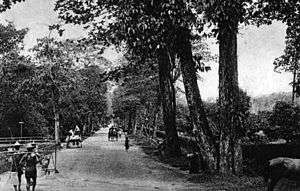Agriculture in Singapore
Agriculture in Singapore is accountable for part of the country's economy. It takes place mostly in the countryside of Singapore, where farms can be found.
History

Agriculture in Singapore became heavily reduced in as early as 1987. In that year, there were officially 2,075 farms in the country, covering an area of 2,037 hectares (5,030 acres), an average of less than 1 hectare (2.5 acres) per farm.[1]
Before modernised development, Orchard Road was a stretch of agricultural orchards. As with many other areas, the farms there soon began to disappear, and Singapore became more reliant on overseas imports.[1] One major issue in 1984 was the health concerns with pig farms in Singapore, in relation to the pollution of the environment.[1]
Major agricultural products
Food crops
Fruits produced in Singapore include durians, rambutans, and mangosteens,[2] while edible fungus produced in the country include mushrooms.[1] There are also farms in the country responsible for the production of eggs, vegetables, poultry,[3] and pork.[1]
Flower crops
Flowers grown in Singapore are exported to other parts of the world,[2] namely Japan, the United States, Australia, and territories in Western Europe.[1] Such flowers include the orchid.[2] There are 153 orchid farms in Singapore.[1] Plants are mostly cultivated in Singapore for decorative purposes.[1]
Fishing
Fish grown in Singapore are mostly kept as aquarium fish,[2] though some fish farms rear fish as food items.[3] Qian Hu Corporation Limited is a major fishery in Singapore, farming, exporting, and importing some thousand fish species.[4]
Statistics
Approximately one percent of Singapore's population are farmers. Farming takes place mostly in the countryside region of Singapore, where the farms are located.[2] Only around 0.87 percent of Singapore's total land area is assigned to agricultural purposes. Agriculture in the country is responsible for less than 0.5 percent of the country's gross domestic product (GDP), as of 2010.[3]
Agricultural safety and health
The agricultural production in Singapore is not enough to deliver to the needs of the country's people, and as such, about 90 percent of the country's food comes from overseas imports, making food safety an issue of high note.[3]
Governance
The Agri-Food & Veterinary Authority (AVA) is the authoritative body in charge of the oversight of agriculture in Singapore.[5] Agricultural imports are habitually reviewed for safety and health,[6] especially during crises such as bird flu outbreaks in other parts of the world.[7]
See also
- Biotechnology
- Economy of Singapore
- List of countries with organic agriculture regulation
- Organic farming by country
References
- 1 2 3 4 5 6 7 8 "Singapore - Agriculture". Country Studies. Retrieved June 2, 2013.
- 1 2 3 4 5 Dana Meachen Rau (2004). Singapore. Marshall Cavendish. pp. 12–. ISBN 9780761417279.
- 1 2 3 4 "Agriculture in Singapore". Commonwealth of Nations. Retrieved June 2, 2013.
- ↑ "Qian Hu Corporation Limited". Retrieved June 2, 2013.
- ↑ "Corporate Identity". Agri-Food and Veterinary Authority of Singapore. Retrieved June 2, 2013.
- ↑ "Agri-Food and Veterinary Authority (Processed Food)". Singapore Customs. Retrieved June 2, 2013.
- ↑ "Singapore free from bird flu; poultry and poultry imports safe for consumption: AVA". Channel News Asia. April 12, 2013.
.svg.png)
